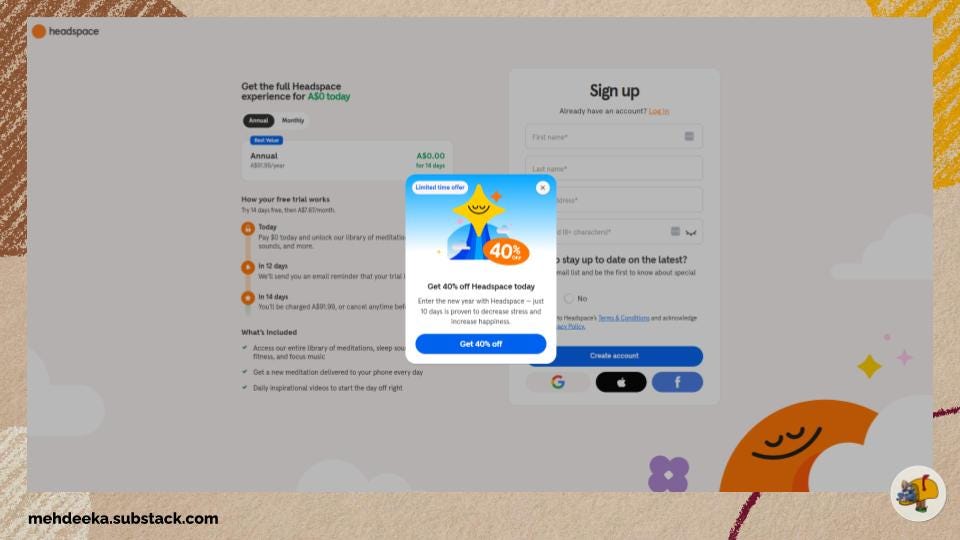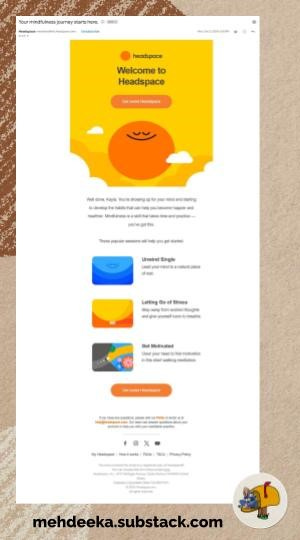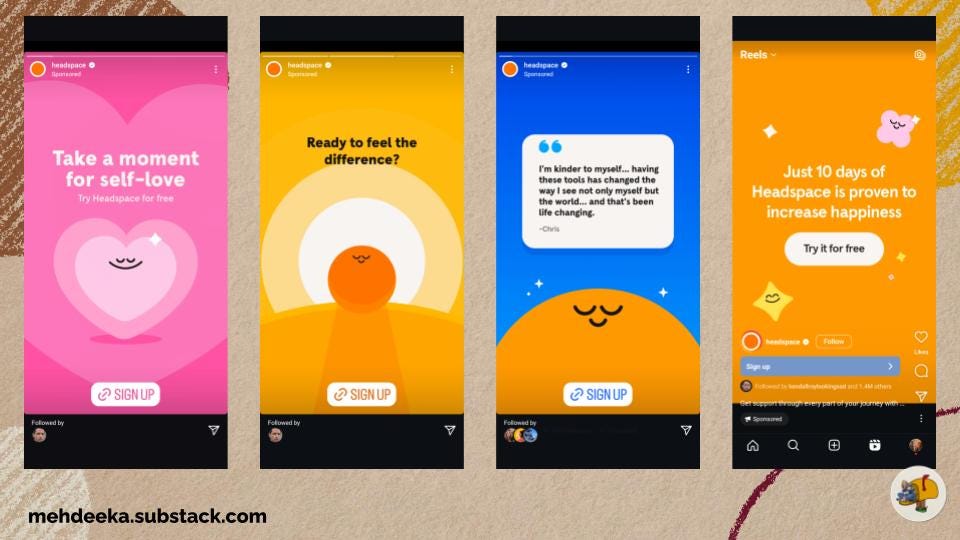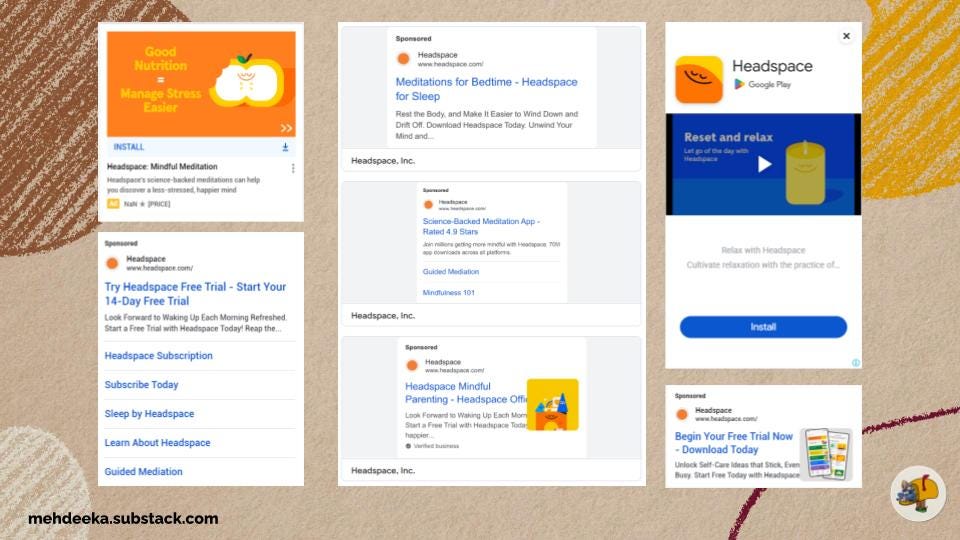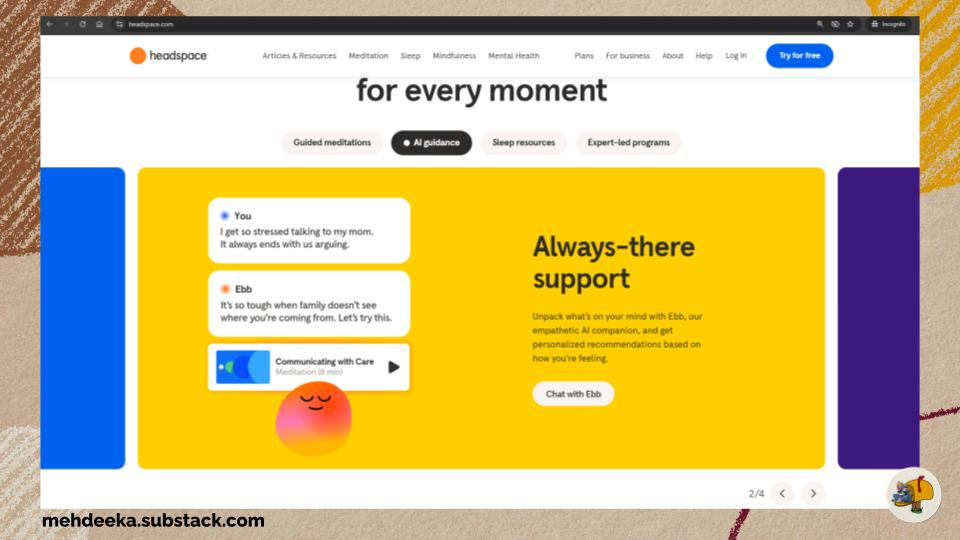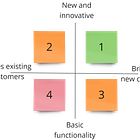A deep dive on Headspace 🍊
Season 9, Issue 1: I beg you, exclude customers from ads
📬In this issue:
A deep dive on Headspace’s marketing, including how they:
Retarget (with flaws)
Onboard new customers
Launch a new feature
Today’s issue has a lot of images so your inbox might cut it off. I’d recommend opening it in your browser, just click the header!
Salutations Mehketeer,
I mentioned in last week’s announcement of S9 that it has taken a bit longer than usual to get back into it because of a personal thing, and it’s actually related to this issue so I’ll just say it.
My dog Major unexpectedly passed away and it lead to me really struggling to fall asleep. I got an ad for Headspace and was willing to give it a go so I signed up using an end of year 50% off code… and they have not stopped retargeting me ever since which is annoying but has given me a lot to analyse. So here we are!
A Headspace summary
A B2C app for meditation, sleepcasts, and all things mental health. Established in 2010, based in California, and with a headcount of 1,000+ (according to Wikipedia) and $178M USD of financing, Headspace notably doesn’t have a CMO position.
I think all of this is relevant in evaluating “good” or “bad” marketing, because how many resources you have obviously correlates with your capacity for quality output. So let’s cheer when we’re doing something they’re not and use their highs as inspiration but not comparison.
All the resources below are saved in a Google Drive so you can take a look in full size:
Headspace’s sign up and onboarding experience
I didn’t take a screenshot at the time, but the sign up page doesn’t seem to have changed in the last few months. If you leave the tab open for a while or go to close it, you will get a discount pop up. You can view full sized versions of the login page (with and without the pop up) via the Google Drive link above.
Pros: The landing page confirms you’ll be reminded two days before you’re charged so you’re given a fair chance to cancel. It’s a pretty straight forward sign up page and probably has good conversions.
Cons: It doesn’t take much of a “value” approach with the copy. They do take a value approach to their ad copy, so the disconnect here is a bit jarring. We’ll get into the ads more in a bit, but I really feel like they’re missing a customer experience moment here. The Headspace brand has so much to work with and they’ve built up the “warm and fuzzy” association — Headspace will make you feel better, no matter what you’re struggling with. Where is that on this page? E.g. instead of “sign up” the CTA could be “start feeling better”, “start your meditation”, or something else less generic.
Onboarding
Not all marketing teams are responsible for onboarding, and given Headspace’s size there is probably a dedicated team for this.
I do find the onboarding underwhelming. This email doesn’t mention that they have an app. However I did test it, and if you have the app installed on your phone and click the CTA from your email, it will open the app. If you click links from your desktop, it goes to the login page (which also doesn’t mention they have an app.)
Takeaway lesson: What’s “obvious” may not be obvious to everyone. This could be a friction point for less tech savvy people who would otherwise benefit from the app version.
I don’t remember if the app had any walkthrough and there were no further onboarding emails, so that’s it for this section!
🖼Ads and retargeting, AKA stop advertising to me, you’re too big a company to not be excluding existing customers
I have been BOMBARDED with Headspace ads since signing up. I get more now than I did when I was served the initial ad that converted me.
Now don’t get me wrong, excluding customers from your ads isn’t the most straightforward thing and in fact many of my consulting clients don’t do it. Often I don’t even bring it up because there’s bigger fish to fry and we’ll get to it eventually. But Headspace, valued at $3B, should be doing this.
I genuinely wonder how much money they’ve spent on serving me ads.
Their ads is really where their brand shines. They’ve got their orange ball mascot doing the heavy lifting with very minimal creative differences.
Instagram stories:
Side note: Huge lol that the “followed by” is kendallroylookingsad, very appropriate.
IG Reels, FB feed, IG feed:
Outside of stories, we start getting more variation.
Not retargeting, but here’s Google:
They have a really healthy mix of ad formats for specific placements, as well as consistent messaging and tone throughout all of them.
Once again, big versions of the individual ads are available in the Google Drive:
I checked the LinkedIn ads library, and Headspace is running a grand total of one ad in the US only, for jobs though not to sign up or even targeting the B2B audience.
Tangent: Why is excluding customers from retargeting so hard?
I reached out to my paid media go-to expert, David Brownless and asked him for his take on this:
At a high level, advertisers' ability to target accurately has collapsed in the past 5 years. Some of this is from platforms & cookies/ privicy changes but the most common offender is terrible first-party data.
He gave me three key reasons why excluding customers is difficult:
The customers Google/Meta account email is different to the email used to sign up to your platform
The advertiser is using 'expanded inventory' which will push out targeting on a adset or adgroup
The advertiser is using something like ADV+ which doesn't let you do audience negatives
However, he also added this:
At the end of the day this is an odd thing to focus on. Can guarantee ad fraud is costing you more than a few impressions to existing customers.
Takeaways from Headspace ads
Pros: I love Headspace as an example of few assets, many ads. They’ve obviously invested into a brand identity that is flexible, yet simple and still incredibly recognisable. It doesn’t look like they’re currently running them, but I do recall a previous campaign where the ad was a video of the orange character getting bigger and smaller, and you are supposed to breathe along to it — a super simple way to demonstrate the outcomes (clarity, peace, restfulness) that comes from using their product, all demonstrated from a couple of deep breaths. It also builds a lot of positive brand sentiment because it’s a helpful ad, even if you have no interest in the product.
What we can take away from this is an upfront investment in brand identity and flexible brand elements can save you a lot of time creating ad variations in the future.
I’ve also got to say Headspace probably has the most interesting Google ads library I’ve ever stalked.
Cons: I really shouldn’t be seeing these ads, that’s the only con here.
Meet Ebb
Ebb is Headspace’s AI chat feature that launched in October of 2024.
Ebb was first brought to my attention in an email:
Initially my reaction was “yikes” because ethically I don’t think companies should be collecting therapy-esque data from customers.
For science, I tried it out. I was pleasantly surprised it’s more like a content matching system. You tell it how you feel, it’ll reply with something quite validating and explicitly call out it won’t give you advice, and then there are two CTAs:
Suggest an activity
Summarise the chat
“I want you to know that I’m here to listen and support you through this conversation, but I’m not designed to give direct advice or counseling.” 10 points for including this, it gives the product a lot more credibility.
Back to the email, it’s super simple. The value proposition is an emotional one, feel seen, and it’s made tangible by the copy anytime, anywhere. The product here is validation on tap. They list use cases: unpack relationship challenges, work stress, sleep issue, and more.
This really is a bit of a masterclass in less is more, with a product marketing checklist of value, use cases, a basic feature description (the pre-header is “your AI companion”), and a product image.
Where it starts to fall apart is that this was it. I looked on Headspace’s blog, there’s no announcement. Within the app there aren’t notifications, so no announcement there. What’s more, the word “Ebb” doesn’t appear anywhere in-product. The top right of the home screen says “Reflect” which opens Ebb, but when you get told “Meet Ebb” and then you can’t find the word Ebb anywhere, it’s confusing!
The Ebb user flow:
How Ebb was launched
So as a user who signed up in December, I missed the actual launch of Ebb. I got the email on February 15, about two months after signing up and I can’t say for certain if it was part of a campaign, an automated flow, or something else.
The launch of Ebb was announced by an exclusive with Fast Company and followed up by CNET. This is really impressive — feature releases are not usually something that you’d be able to get press for. The Fast Company piece quotes employees, but not customers or outside experts which is what you’d usually need to beef up a piece like this.
I reached out to the Mehdeeka PR in Residence, Harrison Polites to ask for his take on this, and he surprised me with his answer:
There’s a few interesting points with this story. Firstly, it’s been plainly pitched as an exclusive and the reporter was offered an interview — which she took up. I’d wager this approach was the best way to get this news high profile coverage. Headspace is no Apple or Google. Those companies typically release product news via their blogs and see it covered everywhere due to audience interest in their brands. To get uptake in a Tier 1 outlet, Headspace had to negotiate the coverage directly with a reporter.
An approach like this may work best for brands with a significant presence, like Headspace, but not enough reach to generate interest with every announcement. As a PR, we can pitch news like this as a bellwether to see where a brand is at in terms of its profile. But as a rule of thumb, if you aren’t doing any high profile brand-based marketing, chances are your brand won’t be strong enough to justify its own story like this. Be under no illusion: product news from companies generally isn’t news. The news value here is that breaking information that may be of interest to Headspace’s global existing user base; the reporter likely wrote the story with that in mind.
It’s also commendable the reporter did an interview here despite it being an easy dropped piece of media. Could more work have gone into the piece? Possibly. Would it have led to it being stronger or serving a different function? Likely not.
From an Australian context, I’d say around one in every ten media queries I receive a month results in an actual interview.
(Harrison’s real title is Director, The Media Accelerator, and author of Infinite Lives. If you’re looking for someone to work with on PR for tech, he’s THE guy.)
On Headspace’s website, Ebb is featured in a few places.
A module on the home page (see below for screenshot)
Screenshots of the landing/product pages are in the Google drive in case they change or the links break.
What’s surprising is Ebb isn’t in the navigation bar or menu.
Going back to Headspace’s size and funding, I would expect more in the rollout, especially considering this feature has been around for four months now. Their Instagram account has a grand total of four posts about Ebb, which were posted within a three-week span around the October launch date and then… never mentioned again?
Here’s a related Mehdeeka issue about product launches needing to have a plan for business as usual and not just the bang of a launch:
The ongoing work of a new product/feature joining an existing roster is missing. In 2022 Headspace acquired Sayana, a mental health AI startup, and presumably that became Ebb. The details of the acquisition aren’t public, but presumably you’d want your investment to pay off by ensuring uptake is high.
Ebb is only available in the US, Canada, and Australia - but this would surely be big enough of a market that promoting it on social media would be fine and websites can be geo-specific (which again, a company as big as Headspace should be able to do.)
Final thoughts
It’s good to be back! I really cherish that you let me into your inbox to vomit the contents of my brain out, unfiltered.
Headspace also has a B2B arm, which I didn’t get into here. While snooping all their ad libraries, I didn’t see any B2B ads. You can check out the site for it here.
That’s it for the Season 9 opener! Was it worth the wait? Tell me yes in the comments.
Ciao,
Kayla


